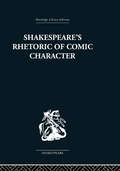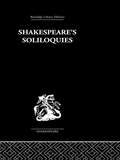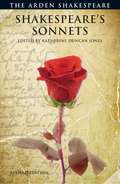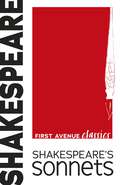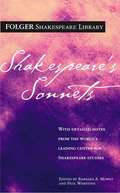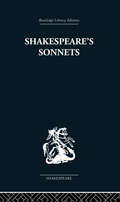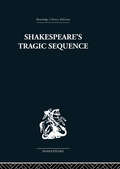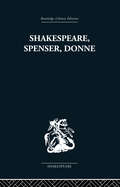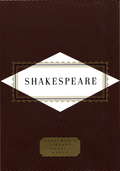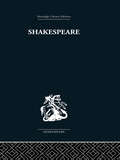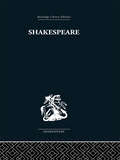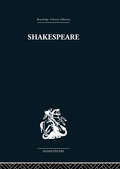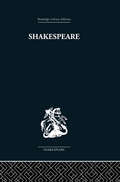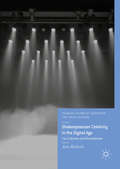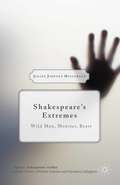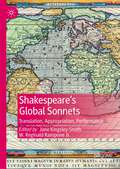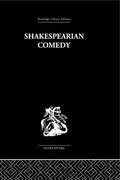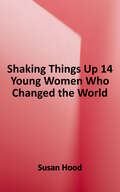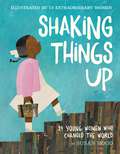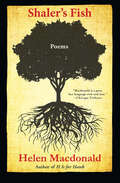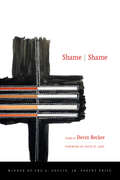- Table View
- List View
Shakespeare's Rhetoric of Comic Character: Dramatic Convention In Classical And Renaissance Comedy
by Karen NewmanFirst published in 1985. In this revisionist history of comic characterization, Karen Newman argues that, contrary to received opinion, Shakespeare was not the first comic dramatist to create self-conscious characters who seem 'lifelike' or 'realistic'. His comic practice is firmly set within a comic tradition which stretches from Plautus and Menander to playwrights of the Italian Renaissance.
Shakespeare's Soliloquies
by Wolfgang Clemen Ingeborg BoltzFirst published in 1987. Often the best known and most memorable passages in Shakespeare's plays, the soliloquies, also tend to be the focal points in the drama. Twenty-seven soliloquies are examined in this work, illustrating how the spectator or reader is led to the soliloquy and how the drama is continued afterwards. The detailed structure of each soliloquy is discussed, as well as examining them within the structure of the entire play - thereby extending the interpretation of the work as a whole.
Shakespeare's Sonnets (The Arden Shakespeare, Third Series)
by William Shakespeare Katherine Duncan-JonesThe author Katherine Duncan Jones explores the issues of sexuality to be found in poems of Shakespeare, making this a truly modern edition for todays readers and students. This revised edition has been updated and corrected in the light of new scholarship and critical thinking since its first publication.
Shakespeare's Sonnets (First Avenue Classics ™)
by William ShakespeareAlong with writing comedic and dramatic plays, William Shakespeare was also a master poet. Using the sonnet structure (three quatrains and a final couplet composed in iambic pentameter), he composed 154 poems covering timeless themes of love, beauty, and mortality. The poems' subjects—the Fair Youth, the Dark Lady, and the Rival Poet—have become nearly as famous as the sonnets themselves. While not the first to write poems in sonnet form, Shakespeare's sonnets are considered the most influential examples of this style. The sonnets were first published in a 1609 quarto; this is an unabridged collection of all of Shakespeare's iconic sonnets, including Sonnet 18 ("Shall I compare thee to a summer's day?"), Sonnet 116 ("Let me not to the marriage of true minds/ Admit impediments"), and Sonnet 130 ("My mistress' eyes are nothing like the sun").
Shakespeare's Sonnets (The Folger Shakespeare Library)
by William Shakespeare Barbara A. Mowat Paul WerstineSavor the most celebrated love poems in the English language. Written almost 400 years ago, the sonnets of William Shakespeare are passionate and exalted, rich in imagery and alliteration, and full of mystery and intrigue. This selection presents all 154 sonnets composed from 1593-1601. In words and rhyme, he reveals his infatuation with the "Dark Lady," his relationship with a rival poet, and his private thoughts on love, death, beauty, and truth: timeless themes that span the centuries to touch our hearts today.
Shakespeare's Sonnets (Unwin Critical Library)
by Kenneth MuirThis edition first published in 1979. Discussing Shakespeare's sonnets in relation to sonnets by Italian, French and English poets, Kenneth Muir shows how they were influenced by Shakespeare's reading of Sidney, Erasmus and Ovid and discusses their art in terms of construction, sound patterns and imagery. He considers the relationship of the sonnets to Shakespeare's dramatic writing, while stressing the dramatic element in the sonnets themselves. Finally he surveys the changing attitudes to the sonnets during the last three centuries.
Shakespeare's Sources: Comedies and Tragedies
by Kenneth MuirFirst published in 1957. This book finds discovers what the sources to Shakespeare's Comedies and Tragedies really were, considers the dramatic reasons for Shakespeare's departure from them and provides many examples of the way in which he made use of his general reading for particular scenes and speeches. Kenneth Muir shows that Shakespeare frequently uses more than one source and sometimes as many as eight.
Shakespeare's Tragedies
by G B HarrisonFirst published in 1951. G B Harrison here recognizes that Shakespeare's tragedies were intended for performance in a theatre and that the playwright's conspicuous gift among his contemporaries was a sympathy for joy and sorrow, pity and terror, and right and wrong of his people. The plays covered are: Titus Andronicus, Romeo and Juliet, Julius Caesar, Hamlet, Troilus and Cressida, Othello, King Lear, Macbeth, Antony and Cleopatra, Coriolanus and Timon of Athens.
Shakespeare's Tragic Sequence
by Kenneth MuirFirst published in 1972. The emphasis of this book is that each of Shakespeare's tragedies demanded its own individual form and that although certain themes run through most of the tragedies, nearly all critics refrain from the attempt to apply external rules to them. The plays are almost always concerned with one person; they end with the death of the hero; the suffering and calamity that befall him are exceptional; and the tragedies include the medieval idea of the reversal of fortune.
Shakespeare, Alchemy and the Creative Imagination
by Margaret HealyShakespeare's Sonnets and A Lover's Complaint constitute a rich tapestry of rhetorical play about Renaissance love in all its guises. A significant strand of this is spiritual alchemy: working the 'metal' of the mind through meditation on love, memory work and intense imagination. Healy demonstrates how this process of anguished soul work - construed as essential to inspired poetic making - is woven into these poems, accounting for their most enigmatic imagery and urgency of tone. The esoteric philosophy of late Renaissance Neoplatonic alchemy, which embraced bawdy sexual symbolism and was highly fashionable in European intellectual circles, facilitated Shakespeare's inscription of an interior drama of a desiring mind creating poetry. Arguing that Shakespeare's incorporation of alchemical textures throughout his late works is indicative of an artistic stance promoting religious toleration and unity, this book sets out a crucial new framework for interpreting the 1609 poems, and transforms our understanding of Shakespeare's art.
Shakespeare, Revenge Tragedy and Early Modern Law: Vindictive Justice (Early Modern Literature in History)
by Derek DunneThis book, the first to trace revenge tragedy's evolving dialogue with early modern law, draws on changing laws of evidence, food riots, piracy, and debates over royal prerogative. By taking the genre's legal potential seriously, it opens up the radical critique embedded in the revenge tragedies of Kyd, Shakespeare, Marston, Chettle and Middleton.
Shakespeare, Spenser, Donne: Renaissance Essays
by Frank KermodeFirst published in 1971. This collection of essays discusses some of the central works and areas of literature in the Renaissance period of cultural history. Contents include: Spenser and the Allegorists; The Faerie Queene, I and V; The Cave of Mammon; The Banquet of Sense; John Donne; The Patience of Shakespeare; Survival fo the Classic; Shakespeare's Learning; The Mature Comedies; The Final Plays.
Shakespeare: Poems
by William ShakespeareThe Everyman's Library Pocket Poets hardcover series is popular for its compact size and reasonable price which does not compromise content. Poems: Shakespeare contains selections from Shakespeare's work, including his sonnets, his narrative poems Venus and Adonis and The Rape of Lucrece, songs and speeches, and an index of first lines.
Shakespeare: The Cambridge Dover Wilson Shakespeare (cambridge Library Collection. Literary Studies) (Cambridge Dover Wilson Shakespeare Ser. #Vol. 17)
by George Ian DuthieFirst published in 1951. 'The book has the sterling qualities of shrewd sense and acumen that mark the 'rational' classical school of Shakespeare criticism.' Notes and Queries 'Professor Duthie's approach is direct and extremely objective. With no axe to grind, he pays impartial court to most of the great schools of Shakespearian criticism.' Cambridge Daily News 'Professor Duthie has much to say that is wise and judicious'. Times Literary Supplement. Contents include: Shakespeare's Characters and Truth to Life; Shakespeare and the Order-Disorder Antithesis; Comedy; Imaginative Interpretation and Troilus and Cressida; History; Tragedy; The Last Plays.
Shakespeare: The Dark Comedies to the Last Plays: from satire to celebration (Shakespeare Survey Ser. #44)
by R A FoakesFirst published in 1971. This volume explains and analyses the last plays of Shakespeare as dramatic structures. Beginning from the dark comedies, the author describes the ways in which Shakespeare was affected by the new techniques and possibilities for drama opened up by the innovations of the years after 1600, notably by the rise in children's companies. The main line of development of Shakespeare's dramatic skills is shown as leading from the dark comedies, through the late tragedies, to the last plays. A major part of the book is devoted to analyses of Cymbeline, The Winter's Tale, The Tempest and King Henry VIII.
Shakespeare: The Poet in his World
by M. C. BradbrookFirst published in 1978. In this study, Shakespeare's own life story and the development of English theatrical history are placed in the wider context of Elizabethan and Jacobean times, but the works themselves are the final objective of this 'applied biography'. The main contention of the book is that Shakespeare's life was the lure of the stage itself which inspired him to transform what everyday life provided into the worlds of Hamlet, King Lear and Prospero.
Shakespeare: The art of the dramatist (Princeton Legacy Library #1782)
by Roland Mushat FryeThis edition first published in 1982. Previous edition published in 1972 by Houghton Mifflin. Outlining methods and techniques for reading Shakespeare's plays, Roland Frye explores and develops a comprehensive understanding of Shakespeare's drama, focussing on the topics which must be kept in mind: the formative influence of the particular genre chosen for telling a story, the way in which the story is narrated and dramatized, the styles used to convey action, character and mood, and the manner in which Shakespeare has constructed his living characterizations. As well as covering textual analysis, the book looks at Shakespeare's life and career, his theatres and the actors for whom he wrote and the process of printing and preserving Shakespeare's plays. Chapters cover: King Lear in the Renaissance; Providence; Kind; Fortune; Anarchy and Order; Reason and Will; Show and Substance; Redemption and Shakespeare's Poetics.
Shakespearean Celebrity in the Digital Age: Fan Cultures and Remediation (Palgrave Studies in Adaptation and Visual Culture)
by Anna BlackwellThis book offers a timely examination of the relationship between Shakespeare and contemporary digital media. By focusing upon a variety of ‘Shakespearean’ individuals, groups and communities and their ‘online’ presence, the book explores the role of popular internet culture in the ongoing adaptation of Shakespeare’s plays and his general cultural standing. The description of certain performers as ‘Shakespearean’ is a ubiquitous but often throwaway assessment. However, a study of ‘Shakespearean’ actors within a broader cultural context reveals much, not only about the mutable face of British culture (popular and ‘highbrow’) but also about national identity and commerce. These performers share an online space with the other major focus of the book: the fans and digital content creators whose engagement with the Shakespearean marks them out as more than just audiences and consumers; they become producers and critics. Ultimately, Digital Shakespeareans moves beyond the theatrical history focus of related works to consider the role of digital culture and technology in shaping Shakespeare’s contemporary adaptive legacy and the means by which we engage with it.
Shakespeare’s Extremes: Wild Man, Monster, Beast (Palgrave Shakespeare Studies)
by Julián Jiménez HeffernanShakespeare's Extremes is a controversial intervention in current critical debates on the status of the human in Shakespeare's work. By focusing on three flagrant cases of human exorbitance - Edgar, Caliban and Julius Caesar - this book seeks to limn out the domain of the human proper in Shakespeare.
Shakespeare’s Global Sonnets: Translation, Appropriation, Performance (Global Shakespeares)
by Jane Kingsley-Smith W. Reginald Rampone Jr.This edited collection brings together scholars from across the world, including France, Italy, Germany, Hungary, Japan, the USA and India, to offer a truly international perspective on the global reception of Shakespeare’s Sonnets from the 18th century to the present. Global Shakespeare has never been so local and familiar as it is today. The translation, appropriation and teaching of Shakespeare’s plays across the world have been the subject of much important recent work in Shakespeare studies, as have the ethics of Shakespeare’s globalization. Within this discussion, however, the Sonnets are often overlooked. This book offers a new global history of the Sonnets, including the first substantial study of their translation and of their performance in theatre, music and film. It will appeal to anyone interested in the reception of the Sonnets, and of Shakespeare across the world.
Shakespearian Comedy
by H. B. CharltonFirst published in 1938. This is a survey of Shakepeare's comedies which illustrates the playwright's increasing grasp on the art and idea of comedy. Themes, characters and plays covered include: Romanticism in Shakespearian comedy; Shakespeare's Jew, Falstaff, The Taming of the Shrew, A Midsummer Night's Dream, and The Dark Comedies.
Shaking Things Up: 14 Young Women Who Changed the World
by Susan HoodIn this book of poems, you will find Mary Anning, who was just thirteen when she unearthed a prehistoric fossil. You’ll meet Ruby Bridges, the brave six-year-old who helped end segregation in the South. And Maya Lin, who at twenty-one won a competition to create a war memorial, and then had to appear before Congress to defend her right to create. And those are just a few of the young women included in this book. <p><p>Readers will also hear about Molly Williams, Annette Kellerman, Nellie Bly, Pura Belpré, Frida Kahlo, Jacqueline and Eileen Nearne, Frances Moore Lappé, Mae Jemison, Angela Zhang, and Malala Yousafzai—all whose stories will enthrall and inspire. This poetry collection was written, illustrated, edited, and designed by women and includes an author’s note, a timeline, and additional resources. With artwork by award-winning and bestselling artists including Selina Alko, Sophie Blackall, Lisa Brown, Hadley Hooper, Emily Winfield Martin, Oge Mora, Julie Morstad, Sara Palacios, LeUyen Pham, Erin Robinson, Isabel Roxas, Shadra Strickland, and Melissa Sweet.
Shaking Things Up: 14 Young Women Who Changed the World
by Susan Hood“Each poem and illustration shines with a personality all its own.” —Shelf Awareness (starred review)“This book has definitely made an impact on my life.” —Kitt Shapiro, daughter of Eartha KittFresh, accessible, and inspiring, Shaking Things Up introduces fourteen revolutionary young women—each paired with a noteworthy female artist—to the next generation of activists, trailblazers, and rabble-rousers.From the award-winning author of Ada’s Violin and Lifeboat 12, Susan Hood, this is a poetic and visual celebration of persistent women throughout history.In this book of poems, you will find Mary Anning, who was just thirteen when she unearthed a prehistoric fossil. You’ll meet Ruby Bridges, the brave six-year-old who helped end segregation in the South. And Maya Lin, who at twenty-one won a competition to create a war memorial, and then had to appear before Congress to defend her right to create.And those are just a few of the young women included in this book. Readers will also hear about Molly Williams, Annette Kellerman, Nellie Bly, Pura Belpré, Frida Kahlo, Jacqueline and Eileen Nearne, Frances Moore Lappé, Mae Jemison, Angela Zhang, and Malala Yousafzai—all whose stories will enthrall and inspire. This poetry collection was written, illustrated, edited, and designed by women and includes an author’s note, a timeline, and additional resources.With artwork by award-winning and bestselling artists including Selina Alko, Sophie Blackall, Lisa Brown, Hadley Hooper, Emily Winfield Martin, Oge Mora, Julie Morstad, Sara Palacios, LeUyen Pham, Erin Robinson, Isabel Roxas, Shadra Strickland, and Melissa Sweet.A 2019 Bank Street Best Book of the Year Named to the 2019 Texas Topaz Nonfiction Reading ListSelected for CCBC Choices Book 2019Selected as a Notable Social Studies Trade Books for Young People 2019Named to the Cuyahoga County Public Library’s 2018 list of Great Books for Kids2020-2021 South Carolina Picture Book Award Nominee
Shaler's Fish: Poems (Books That Changed the World)
by Helen Macdonald“Devoted readers of H Is for Hawk will find Macdonald’s gift for stunning language, patient curiosity, and expansive wisdom on full display in her poems.”—Publishers WeeklyFrom the naturalist and author of the New York Times bestseller H is for Hawk, which appeared on more than twenty-five Best Books of the Year lists, Shaler’s Fish is a collection of poetry that roams both the outer and inner landscapes of the poet’s universe, seamlessly fusing reflections on language, science, and literature with the loamy environments of the natural worlds around her. Moving between the epic (war, history, art, myth, philosophy) and the specific (CNN, Ancient Rome, Auden, Merleau-Ponty), Helen Macdonald examines with humor and intellect what it means to be awake and watchful in the world. These are poems that probe and question, within whose nimble ecosystems we are as likely to encounter Schubert as we are “a hand of violets,” Isaac Newton as a “winged quail on turf.” Nothing escapes Macdonald’s eye and every creature herein—from the smallest bird to the loftiest thinker—holds a significant place in her poems.“Macdonald is a poet of vision and sound, oracular one moment and playful the next, whose first love and only loyalty is to the music of words.” –O, the Oprah Magazine
Shame / Shame
by Devin Becker"Devin Becker's Shame | Shame is a brilliant debut collection. Here, the prose poem has been re-imagined as a cinematic vignette, yet rooted as deeply in the American Northwest as anything in Richard Hugo and David Lynch. Raw, intimate, and elliptical in its metaphysics, Devin Becker's poetry captures an idiomatic recklessness while navigating those angular narratives of our contemporary lives."—David St. John Devin Becker grew up in Fort Wayne, Indiana, and lives in Moscow, Idaho, where he works as digital initiatives librarian at the University of Idaho Library. He was named a 2014 "Mover and Shaker" by Library Journal.
